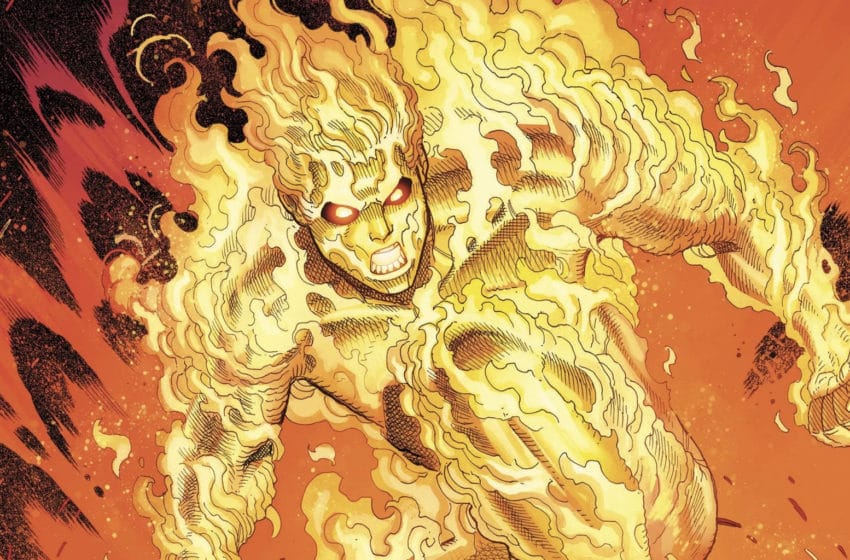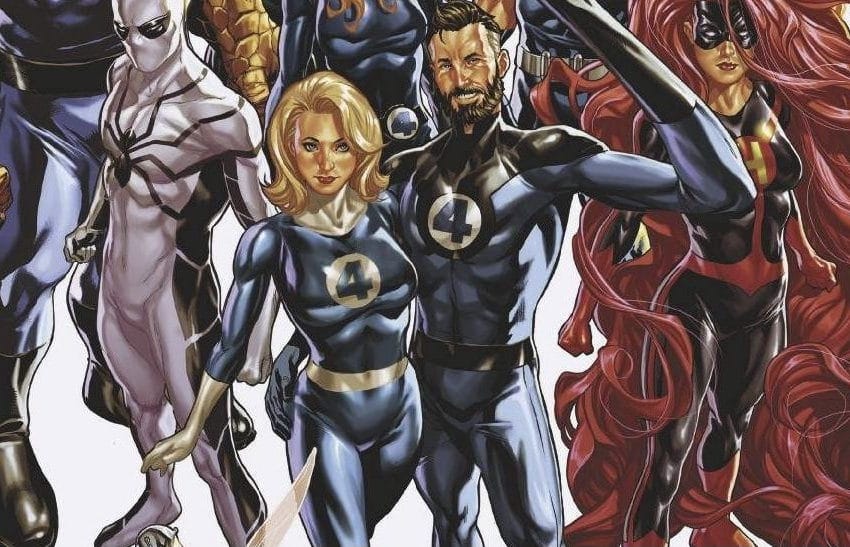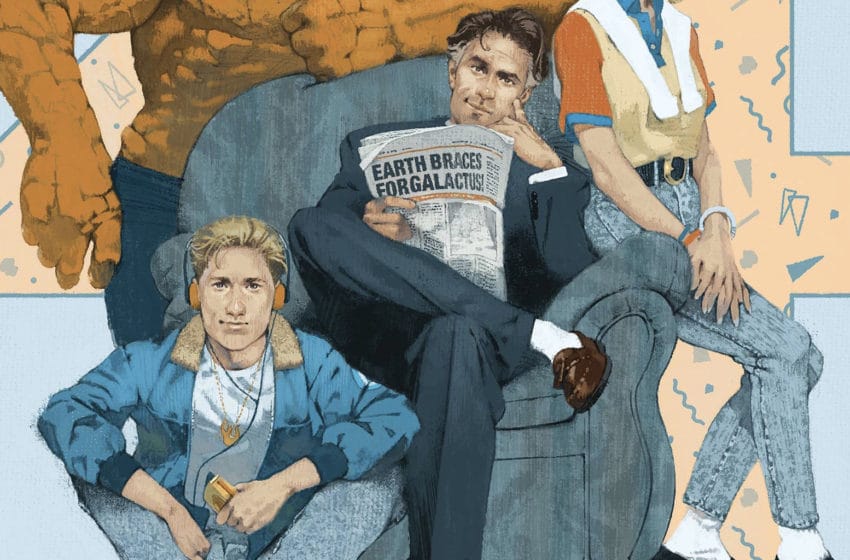Marvel’s First Family celebrates their 60th anniversary with a step back in time in Fantastic Four: Life Story #1. A follow-up to the critically acclaimed Spider-Man: Life Story, this new miniseries finds the Richards family’s history warping and changing slightly with a fluidic resonance throughout America’s Atomic Age. Written by Mark Russell, drawn by Sean Izaakse, colored by Nolan Woodard and lettered by Joe Caramagna.
Justin Partridge: Eyes front, True Believers! Welcome back to the Swingin’ Sixties with our coverage of Fantastic Four: Life Story! I’m Justin “Imperious Rex!” Partridge, and I am incredibly dorky and head-over-heels in love with the FF. Though you wouldn’t know it by my regular coverage of the latest volume.
But to balance out my cynicism, I’ve brought along a partner for this miniseries, making this a true Marvel Two-in-One! Please join me in welcoming Fellow Fantastic Four Fan, Dan “The Man” Grote!
Dan Grote: Haha, thank you for that spirited introduction, Justin. Though, if I’m being transparent, I’m less a Fantastic Four fan and more a fan of Mark Russell, the Life Story concept and, frankly, your writing, so this lets me go deep on all three. It’s a win-win-win, a Triple Winny! But I have to imagine, given your love of the FF and your … criticisms of the current run, this is the breath of fresh air you were looking for.
JP: I have been looking forward to this for so long, y’all. I also don’t have much going on atm.
DG: Wait, aren’t you covering Heroes Reborn?
JP: WE AREN’T TALKING ABOUT THAT HERE, DAN! FORWARD … to TOMORROW!
America, 1961

JP: So while the Life Story title usually ends up taking more divergent narrative pathways, Fantastic Four: Life Story #1 opens with a pretty instantly recognizable setup.
America is losing the space race to the Russians, and President John F. Kennedy is getting nervous about NASA’s prospects after three failed launches. Enter new scientific wunderkind Reed Richards, who is enlisted by Kennedy to take America to the stars. Much to the chagrin of Kennedy’s former space adviser, Dr. Ricardo Jones.
For a Life Story setup, I found this a touch basic and a little too beholden to “established” Marvel history (itself still in a state of flux thanks to the ongoing The Marvels miniseries). BUT that said, I still can’t deny the charm and highly pleasing visual aesthetic of seeing the FF back in their original time period. What did you think of this opening, Dan?
DG: Part of the Life Story formula is tying the rise of superheroes to commensurate real-world events. Hence why Spider-Man: Life Story dealt so heavily with the Vietnam War (and not, speaking of The Marvels, that Siancong business). The FF’s origin is inseparable from the space race of the 1950s and ’60s, so it makes sense to use that as the base for this story and extrapolate out from there. What will be interesting to see going forward is if FF’s Life Story blends with the continuity of Chip Zdarsky and Mark Bagley’s Spider-Man tale, which used Reed Richards heavily in a supporting role.
JP: OH ABSOLUTELY. And this precise stuff that you mention here is why I quickly got over the relatively grounded nature of the opener and just went with it.
Like you, I’m also a pretty big Russell fan, and seeing him once again tightly intertwining social-level storytelling with high-concept lunacy is a real treat here. AND ALSO, a very canny point as to the comparison we have to make between this and the “main” title.
While Slott has done his own mucking about with FF continuity, his volume seems very much steeped in the modern approach to the FF; more as strictly superheroes and less as celebrities/explorers. Slott is also somewhat beholden to making them a part of the fabric of the 616. Russell here, is pretty much unmoored from that altogether.
Despite a few choice Avengers cameos and mentions of other Marvel bit players, Russell is pretty much building this historical sandbox AS he plays in it. I think this opening is a touch rushed, just with the amount of information it has to dispense, but I was still just truly interested in LEARNING about it all as we go.
From the Age of Aquarius to the Age of Marvels

JP: From there and after the team’s fateful encounter with cosmic rays, Russell settles into a fun and deeply affectionate “walking tour” of Life Story’s timeline. Moving from ’61 into ’69 (DG: Nice), using Reed as the “lead” and following his family’s growth through the decade.
Again, I was slightly struck at just how closely Russell keeps to real-life history. But also again, VERY much taken by the wonderfully accurate characterizations Russell has deployed for the team and how well he is folding in real places and people into the fabric of the narrative. For example, as the family’s celebrity rises after their trip to space, they are called upon to basically do a superpowered press tour. Including a stopover on The Dick Cavett Show!
Casual readers might not pick up fully on these sorts of period details, but I really appreciated Russell both leaning into the “celebrity status” that the FF enjoyed in their early days and also making good on Marvel’s old-school promise of delivering a “world right outside our window.” How did this Sixties texture grab you, Dan?
DG: For the most part, I liked it. Who wouldn’t love a scene where Marvel’s First Family shakes hands with the Beatles, especially knowing that story about Jack Kirby and Paul McCartney.
But I want to talk about one panel in particular …
As we progress through the ’60s, we see Sue Richards participate in a civil rights march. She is notably the only non-Black person in the panel, and she is at the center of a line of marchers. And it’s bothering the crap out of me.
There is something about centering a white woman in an event meant to depict, ever so briefly, the struggle for Black rights, that is well-intentioned but tone deaf. It’s a breadcrumb where the audience for that sort of thing would want a meal. It’s the kind of thing that will get put online and dunked all to hell on Wednesday, drowning out the rest of what is otherwise an effective story.
Russell is a socially conscious writer who does some of his best work in self-contained superhero stories. And the Civil Rights Movement is an indelible part of the era in which this comic is set, though not necessarily something crucial to the FF’s sci-fi schtick. This is a hiccup, but damn does it stick out like a sore thumb.
(That said, I fully recognize I’m not the person people should be listening to when it comes to this stuff, so your mileage may vary.)
JP: NO I ABSOLUTELY UNDERSTAND and do appreciate you calling attention to it.
It is very … White Woman Feminism, for sure. And the feeling doesn’t exactly go away immediately, especially since it’s just ONE panel in particular with no real establishment or growing out to show just how far Sue’s involvement really goes.
On one hand, I DO appreciate Russell at least attempting to show that the FF is trying to parlay their celebrity into social action. The actual image of Sue, fully in her uniform, standing arm in arm with other members of the movement IS striking on a surface level. And speaks to at least a “good intention” that Sue and the team have in regard to their fellow citizens.
But also like you said, it’s JUST the surface level. And on the surface it looks pretty cloying and sweaty (especially since we get NOTHING else) beyond that.
‘I Am Coming For You ALL.’

JP: But as we all well know, NO history of the Fantastic Four is complete without the Devourer of Worlds, and Fantastic Four: Life Story #1 has one DOOZY of a take on Big Purple.
You see, while the rest of the FF is grappling with their new normals and the celebrity their trip to space has brought on, Reed is being haunted by a “vision” he had in space. A vision that is delivered in the form of a stunning “first encounter” with Galactus, lovingly and terrifyingly rendered by artist Sean Izaakse and colorist Nolan Woodard. This gives the issue overall a tactile sense of dread and portentousness that I wasn’t expecting to have this early.
Better still, the creative team use these “visions” of Galactus pretty sparingly, allowing him to feel like a genuine presence and threat unlike the near constant use he’s been given in some of the main Marvel line of books like Donny Cates’ Thor and Al Ewing’s Ultimates run from a few years back.
How did you dig this stuff, Dan? Was seeing Galactus more as an existential threat and less as an actual character appealing to you?
DG: Oh yeah, this is where things get interesting for me. While the rest of the book looks like a Norman Rockwell painting, Galactus looks like the future. Which is to say, he looks like the present. Which is to say, Izaakse and Woodard use modern digital art techniques to make Galactus look like the existential threat he was meant to be in 1966. It would have been easy, and tempting, to depict Galactus as a loving homage to Kirby. Who doesn’t love a good Kirby hat? But to give us the Galactus of, as you said, Thor or The Ultimates, is to give Reed a glimpse of a terrifying future for which he is unprepared.
And this, again, is where Russell and Izaakse’s take differs. Reed is traditionally characterized as a hopeful futurist, a man who sees infinite possibilities, a man who believes he can solve everything. Here, we have a Reed plagued by visions of fear, who sees a universe of “chaos and apathy,” with survival as the ultimate, futile goal. This is Russell’s Reed, not Stan and Jack’s. What do you make of that, Big J?
JP: I ACTUALLY REALLY LOVE IT! And it stands well of a piece with one of my FAVORITE incarnations of Reed; the Reed Richards of the Jonathan Hickman/“Solve Everything” days.
But tackling the first part of your point first, I truly madly deeply love the idea of Reed being faced with a Galactus of “The Future.” It not only gives current readers a nice touchstone of “their” books, but the idea of pitting THESE Fantastic Four against an unyielding but constantly evolving force of Marvel infamy could have some real legs.
But Russell’s Reed in REACTION to this Galactus is the real win for this opening issue, I agree. While the hacky joke is to say that Reed is just constantly aloof and doesn’t understand what’s in front of him, Russell framing that as 1. Completely true but 2. BECAUSE HE’S OBSESSED WITH THE DEATH OF EVERYTHING is Very Good. And provides a nicely humanist dimension to Reed that’s STILL deeply informed by his core characterization.
It’s almost unfair how good this is. I’m not sure it will do much to sway those who already hate Reed (or have been burned on terrible takes on him in books), but I would be OK giving this to people as an example of how and why he can work in books, for sure.
Marvelous Musings
- Give the FF back the boots, gloves and belts in their costumes. Seeing them again here made me realize just how cool those old-school costumes are and how much I don’t like their new, super dark costumes.
- No mention of Latveria at all just yet.
- Also no mention yet of Reed’s college years, so we are wondering if that’s the first major change Russell seems to be making to their “established” lore.
- Crazy how much mileage this comic gets out of FF #51, “This Man … This Monster!”
- For those unfamiliar with the early FF days, Ricardo Jones is a baddie from the first 50 issues, who infiltrated the FF by puppeting Ben Grimm. Here he seems like a Henry Kissinger-like character who still hates Reed Richards.
- Now this makes us wonder just how deeply Russell will be pulling for this series. Is Willie Lumpkin on deck next? Maybe Paste Pot Pete and Wyatt Wingfoot get featured, too?
Dan Grote is the editor-in-chief of ComicsXF, having won the site by ritual combat. By day, he’s a newspaper editor, and by night, he’s … also an editor. He co-hosts WMQ&A: The ComicsXF Interview Podcast with Matt Lazorwitz. He lives in New Jersey with his wife, two kids and two miniature dachshunds, and his third, fictional son, Peter Winston Wisdom.






